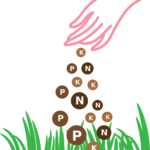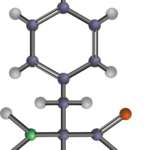Solid matter is one of the most fundamental states in which materials exist, characterized by structural rigidity and resistance to changes in shape and volume. Within the diverse realm of solids, we encounter an intriguing category called atomic solids. These are substances in which the basic building blocks are atoms, bonded or interacting in unique ways. Atomic solids can be classified into three primary types: covalent network solids, metallic solids, and nonmetallic atomic solids. Let’s delve into each of these types to understand their structure, bonding, and properties.
1. Covalent Network Solids
The first category, covalent network solids, is characterized by a continuous and extensive network of covalent bonds. In these solids, atoms are held together by strong covalent bonds in a rigid lattice, creating structures that are often hard, durable, and resistant to external forces. The primary feature of these solids is their extremely high melting and boiling points, a direct result of the significant energy required to break the extensive covalent bonds.
Examples of Covalent Network Solids:
- Diamond: One of the most well-known examples of a covalent network solid is diamond, an allotrope of carbon. In diamond, each carbon atom is tetrahedrally bonded to four other carbon atoms in a three-dimensional lattice. This structure contributes to diamond’s renowned hardness, making it one of the hardest natural materials. Due to the strength of these bonds, diamond has a very high melting point, and it is often used in cutting tools and abrasives.
- Silicon Dioxide (Quartz): Another example is silicon dioxide, commonly known as quartz. In quartz, silicon atoms are bonded to oxygen atoms in a continuous, repeating structure. The strong Si-O bonds make quartz hard and give it a high melting point, making it a vital material in the construction and technology industries.
- Graphite: Unlike diamond, graphite, another carbon allotrope, has a different bonding arrangement. In graphite, carbon atoms are arranged in two-dimensional planes, where each atom is bonded to three others. These planes are held together by weaker van der Waals forces, allowing the layers to slide over each other easily. This gives graphite its lubricating properties and makes it an excellent conductor of electricity.
The distinct structural characteristics of covalent network solids explain why they exhibit high hardness, brittleness, and poor electrical conductivity (with exceptions like graphite). The rigidity of the structure means that when a covalent network solid breaks, it tends to shatter rather than deform.
2. Metallic Solids
The second type of atomic solids is metallic solids, which consist of metal atoms arranged in a highly organized lattice structure. The unique feature of metallic solids is the nature of the bonding, often described as a “sea of electrons.” In this arrangement, valence electrons are not bound to individual atoms but are instead free to move throughout the entire structure. This electron delocalization is what gives metallic solids their distinctive properties.
Properties and Examples of Metallic Solids:
- Electrical Conductivity: One of the hallmark properties of metallic solids is their high electrical conductivity. The freely moving electrons in the “sea” allow electric charges to flow effortlessly through the metal. This property makes metals like copper, aluminum, and gold essential in electrical wiring and electronic components.
- Thermal Conductivity: Metals are also excellent conductors of heat. The free electrons can transfer kinetic energy quickly, distributing heat evenly throughout the material.
- Malleability and Ductility: Another notable feature of metallic solids is their ability to be shaped without breaking. Metals can be hammered into thin sheets (malleability) or drawn into wires (ductility). This behavior arises because the atoms in the metallic lattice can slide past each other without disrupting the overall structure, thanks to the presence of mobile electrons.
- Examples of Metallic Solids: Metals like iron, gold, silver, and copper exemplify metallic solids. Each of these materials demonstrates the typical metallic properties of high melting points, electrical conductivity, and mechanical strength.
The strength of metallic bonds and the versatility of metallic solids make them indispensable in construction, manufacturing, and technological applications. From the steel frameworks of skyscrapers to the intricate circuits in smartphones, metallic solids form the backbone of modern civilization.
3. Nonmetallic Atomic Solids (Noble Gas Solids)
The third type, nonmetallic atomic solids, encompasses solids composed of noble gases, such as helium, neon, argon, and krypton, under conditions of extreme cold. Unlike the other atomic solids, these materials are held together by weak van der Waals forces, specifically London dispersion forces. Since noble gases have complete electron shells, they do not readily form chemical bonds, and the attractive forces between the atoms are minimal.
Properties of Nonmetallic Atomic Solids:
- Low Melting and Boiling Points: Due to the weak van der Waals forces, noble gas solids have incredibly low melting and boiling points. For example, solid helium requires temperatures near absolute zero to form. These low thermal thresholds make noble gas solids highly susceptible to phase changes with small temperature variations.
- Softness and Weak Structure: The lack of strong bonding forces also makes these solids very soft and easily deformable. Unlike covalent or metallic solids, noble gas solids are not useful for structural applications.
- Examples of Nonmetallic Atomic Solids: Solid helium, neon, and argon are examples of nonmetallic atomic solids. These solids are primarily studied in cryogenic research and have specialized applications, such as in low-temperature physics experiments.
Comparison of Atomic Solids
The three types of atomic solids—covalent network, metallic, and nonmetallic—differ significantly in their bonding, structure, and properties. Covalent network solids are characterized by their hardness and thermal stability, metallic solids by their conductivity and malleability, and nonmetallic atomic solids by their softness and low melting points. The differences in bonding and structure account for these variations.
Applications and Significance:
- Covalent Network Solids: Due to their durability and thermal resistance, these solids find applications in industries requiring tough and heat-resistant materials. For instance, diamond is used in industrial cutting tools, and quartz is used in glass manufacturing and timekeeping devices.
- Metallic Solids: The importance of metallic solids cannot be overstated. They are foundational materials for construction, transportation, and electronics. From building bridges to crafting electrical circuits, metallic solids are ubiquitous in our daily lives.
- Nonmetallic Atomic Solids: Although less common, noble gas solids are crucial in specialized fields. For example, liquid helium is used as a coolant in superconducting magnets, like those in MRI machines.
Conclusion
Atomic solids are a fascinating area of study, showcasing the diversity of ways in which atoms can bond and form matter. Covalent network solids reveal the strength of covalent bonding, metallic solids demonstrate the wonders of electron mobility, and nonmetallic atomic solids illustrate the role of weak van der Waals forces. Understanding the principles behind these materials not only sheds light on fundamental physical chemistry but also drives innovations in technology and materials science. Whether in the diamond-tipped drills of construction sites, the copper wires that power our homes, or the cryogenic applications of noble gases, atomic solids are integral to the fabric of our modern world.















